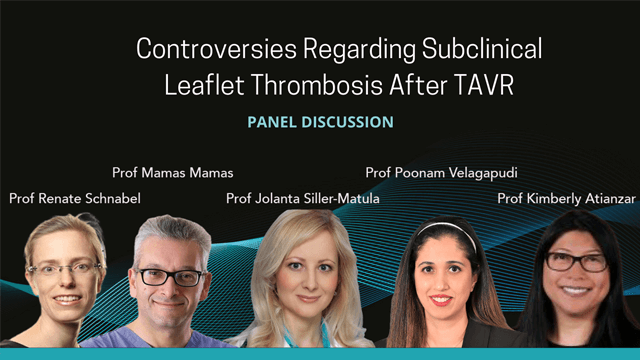Controversies Regarding Subclinical Leaflet Thrombosis After TAVR
Published: 25 February 2021
-
Views:
 1543
1543
-
Likes:
 7
7
-
Views:
 1543
1543
-
Likes:
 7
7
-
 Up Next
Up Next -
 11m 57sPart 3 | Session 3 Panel discussion & Audience Questions
11m 57sPart 3 | Session 3 Panel discussion & Audience Questions
-
 15m 20sPart 1 Subclinical leaflet thrombosis after TAVR: Numbers and facts Jolanta Siller-Matula
15m 20sPart 1 Subclinical leaflet thrombosis after TAVR: Numbers and facts Jolanta Siller-Matula
-
 10m 22sPart 2 | Session 1 PRO Mamas A Mamas
10m 22sPart 2 | Session 1 PRO Mamas A Mamas
-
 10m 45sPart 2 | Session 2 CONTRA Poonam Velagapudi
10m 45sPart 2 | Session 2 CONTRA Poonam Velagapudi
-
 13m 38sPart 2 | Session 3 Panel discussion & Audience Questions Jolanta Siller-Matula, Mamas A Mamas, Poonam Velagapudi, Kimberly Atianzar, Renate B Schnabel
13m 38sPart 2 | Session 3 Panel discussion & Audience Questions Jolanta Siller-Matula, Mamas A Mamas, Poonam Velagapudi, Kimberly Atianzar, Renate B Schnabel
-
 11m 47sPart 3 | Session 1 PRO Kimberly Atianzar
11m 47sPart 3 | Session 1 PRO Kimberly Atianzar
Overview
A substantial number of patients develop a subclinical leaflet thrombosis (SLT) after transcatheter aortic valve replacement (TAVR).
The thrombus forms on the leaflets, which can lead to valve dysfunction and possibly to early valve degeneration. Multidetector computed tomography is the most sensitive imaging technique at detecting SLT.
Patients on antiplatelet drugs are at higher risk to develop SLT as compared to those on anticoagulants. During the live debate, the experts in the field will discuss controversies concerning SLT, including the routine use of oral anticoagulants and CT exams after TAVR.
Learning Objectives
- To learn about the natural history, incidence and clinical implications of SLT
- To learn about the mechanisms that may lead to SLT
- To understand the diagnostic criteria SLT
- To discuss the prevention and treatment options for SLT
Audience
- Interventional cardiologists with focus on TAVR procedures
- Cardiac Imaging specialists (Echocardiography, Computer Tomography)
- General cardiologists
- Specialists interested in management of antithrombotic therapies after TAVR
More from this programme
Part 1
Subclinical leaflet thrombosis after TAVR: Numbers and facts
Part 2
Debate: Patients should receive routine CT screening after TAVR to exclude subclinical valve thrombosis
Faculty Biographies

Renate Schnabel
Consultant in Cardiology
Renate Schnabel is a consultant in cardiology at University Heart Centre Hamburg, Germany. She graduated from medical school in Mainz, Germany in 2002. After a research fellowship at the Framingham Heart Study, Boston University, she moved to Hamburg. She works with clinical and population cohorts and leads national and EU-funded international consortia. She is PI of the German Centre for Cardiovascular Research. Her research interest is in digital cardiology, atrial fibrillation and heart failure, and omics for cardiovascular risk assessment. Very active within professional organizations, she is member on councils of the European Society of Cardiology, American Heart Association and the German Cardiac Society.





